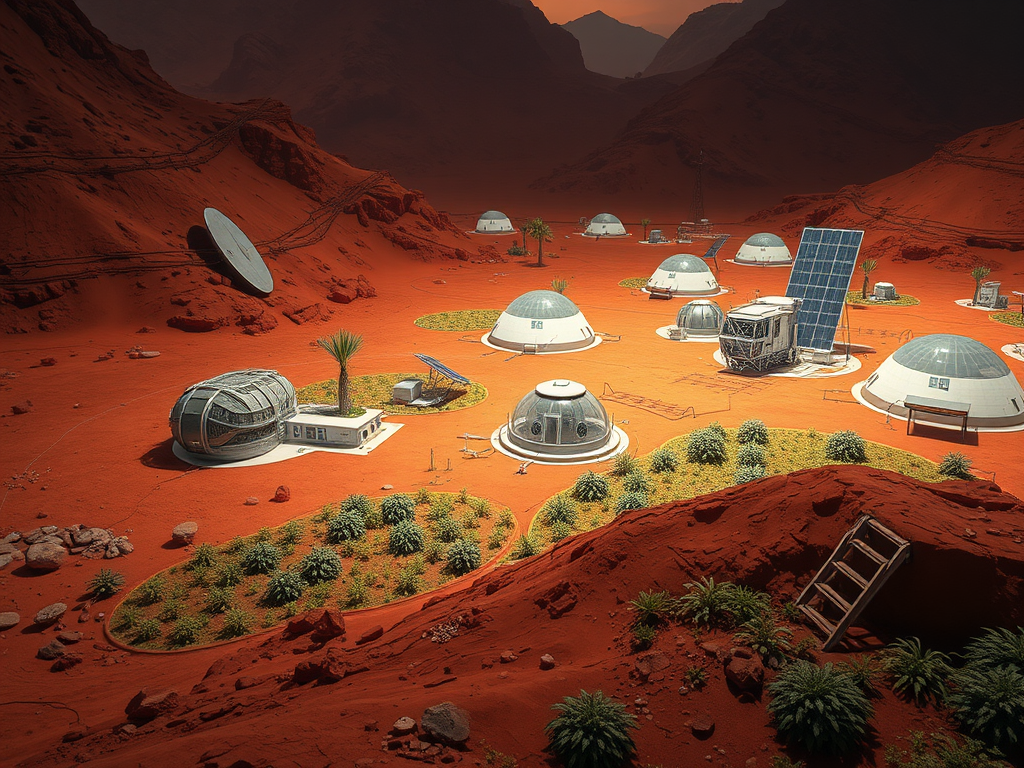Now is the time for space travel, and AI is already working on what our missions to Mars will look like. As vast amounts of data are being created through space research, the need for advanced technologies that recreate Martian conditions grows. One of these technologies comes in the form of sophisticated language models which help researchers tackle problems that arise when realistic Martian environments are created. This article aims to highlight the benefits, challenges, and future prospects of language models in the context of their use for simulating Martian environments.

The Role of Language Models in Habitat Simulation
AI systems that generate human-like text are known as language models. In terms of space research, these models assist scientists in creating simulations of Martian environments by analyzing considerable amounts of data. By using the recognized language patterns in these datasets, it becomes plausible to highlight the difficulties associated with life on Mars. This helps researchers develop simulations with climatic conditions, biological possibilities, and anthropogenic activities, thus creating a detailed scenario of existence on Mars. So, language models help us understand how humans would react to the conditions on Mars. The possibility of simulating such environments can help in planning successful missions.
How Language Models Work in Habitat Simulation
Context-rich models like GPT-3 have an edge over traditional data due to their advanced data processing capabilities through sophisticated algorithms that identify semantic relationships. They are capable of producing text with predictions covering numerous aspects of Martian habitats and can even mimic an astronaut’s experience with plausible interactions of environmental modifications and alien life. Allowing scientists, too, to expand the boundaries of imagination, these models can construct simulations that go beyond mere imitation to include other formats such as images and videos, synthesizing a more comprehensive picture of Mars’s conditions, thus enabling them to envision what life on Mars might actually look like. Consequently, by connecting text data with possible environmental variables, these language models help automate tasks related to mission planning.
The output language models produce is directly proportional to the input received; hence the quality is bound by the quality and variety of data provided. Scientists work toward integrating various datasets with scientific articles, environmental data from Mars rover observations, and archived mission data. This diverse collection ensures that language models make dependable and precise forecasts. Below is a list of specific data sources commonly used for habitat simulations.
- NASA’s Mars Rover observations
- Scientific research journals
- Astronomical databases
- Remote sensing data
- Earth-based analog studies
Through careful data processing, language models develop a contextual understanding, leading to the creation of realistic Martian scenarios.
| Source | Type of Data | Purpose |
|---|---|---|
| NASA Mars Rover | Visual and environmental data | Understanding terrain and climate |
| Research Papers | Scientific analyses | Biological and environmental insights |
| Astrophysical Databases | Cosmic data | Astrobiological modeling |
Benefits of Using AI for Martian Habitat Simulation
There are many benefits to integrating AI into language models while simulating Martian habitats, which aid in futuristic explorations. One of the most remarkable benefits is the enhanced thoroughness of scientists’ analyses and studies. Simulations require AI to perform them effectively. In addition, they yield better predicted outcomes, and through vast amounts of analysis, they create detailed simulations that have a higher likelihood of accurately representing the conditions on Mars. There’s also the ability to adopt new strategies to address issues with space missions through AI.

AI-powered simulators are not only speedy and precise, but they also help foster collaboration among scientists with different perspectives. This facilitates scenario evaluation, which is often difficult with traditional simulations. Simulation accuracy enhances the training provided to astronauts preparing for missions to Mars. AI helps solve potential human challenges related to physiological and psychological issues, in turn greatly enhancing mission safety. The countless advantages that AI brings to space exploration emphasize the need for increased spending on AI technologies.
Challenges and Limitations
Identifying the obstacles AI may encounter when simulating Martian habitats poses significant challenges. One critical hurdle is the lack of data quality and availability. The current data on Mars is scarce, and therefore, researchers have to resort to the use of Earth-based analogs to bridge the gaps. This limitation dampens the realism of the simulations that can be produced by language models. Furthermore, misinterpretation of a given output presents another type of challenge. While AI offers helpful recommendations based on simulation results, the rationale behind such outcomes is not straightforward. This complexity in explanation hinders trust and adoption in the scientific community.
In order to address these problems, there needs to be ongoing SSR research and technology development. Researchers can forge collaborations between foreign space agencies and other research institutions so that broader datasets can be accumulated. In addition, AI tools that improve the understanding of a given output should be developed so that the AI recommendations can be trusted by researchers and astronauts. Such progress would ensure that AI can be harnessed to its full potential to facilitate successful Mars missions.
Conclusion
The dramatically changing field of AI is revolutionizing our methods of space exploration through the simulation of Martian habitats. The use of language models is one of the most useful tools for researchers as it enables them to gain more information about Mars and the possibility of human life on the planet. Solving the challenges that come with this kind of work will require collaborative and innovative approaches. As we move forward in broadening the frontiers of space exploration, the importance of AI in this regard will certainly grow, allowing for wonderful future discoveries.
Frequently Asked Questions
- What are language models, and how do they relate to AI? Language models are AI systems designed to understand and generate human-like text. They analyze language patterns to simulate scenarios based on their programming and training data.
- Why is simulating Martian habitats important? Simulating Martian habitats is crucial for preparing future missions, understanding potential challenges, and ensuring the safety and sustainability of human life on Mars.
- What kind of data is used for simulations? Data used for simulations can include environmental data from Mars, research studies on microbial life, human physiological responses, and historical space mission data.
- What are some real-world applications of AI in space exploration beyond Mars? AI applications extend to satellite data analysis, asteroid mining simulation, mission planning, and even the development of autonomous spacecraft systems.
- How can challenges in data quality be addressed? Improving data quality can involve collaboration between international space agencies, increased robotic exploration to gather more data, and partnerships with universities and research institutions.


